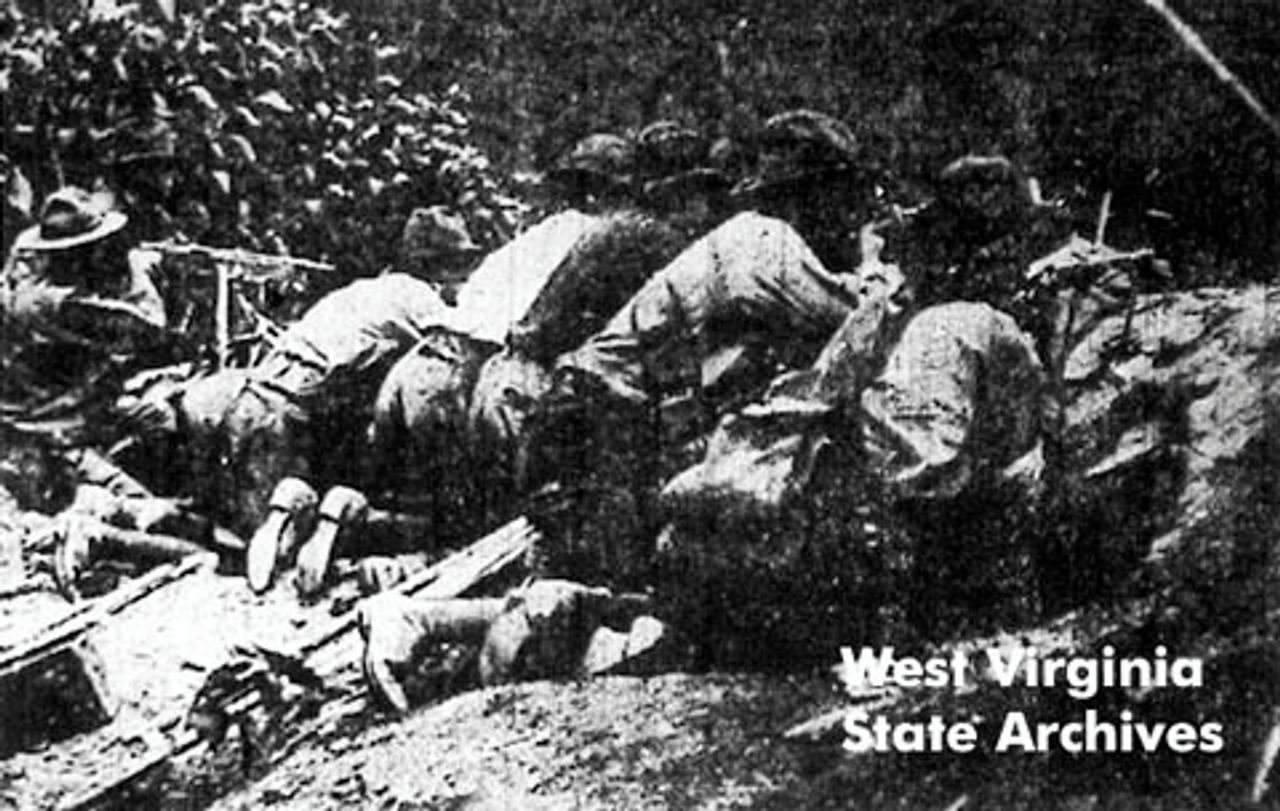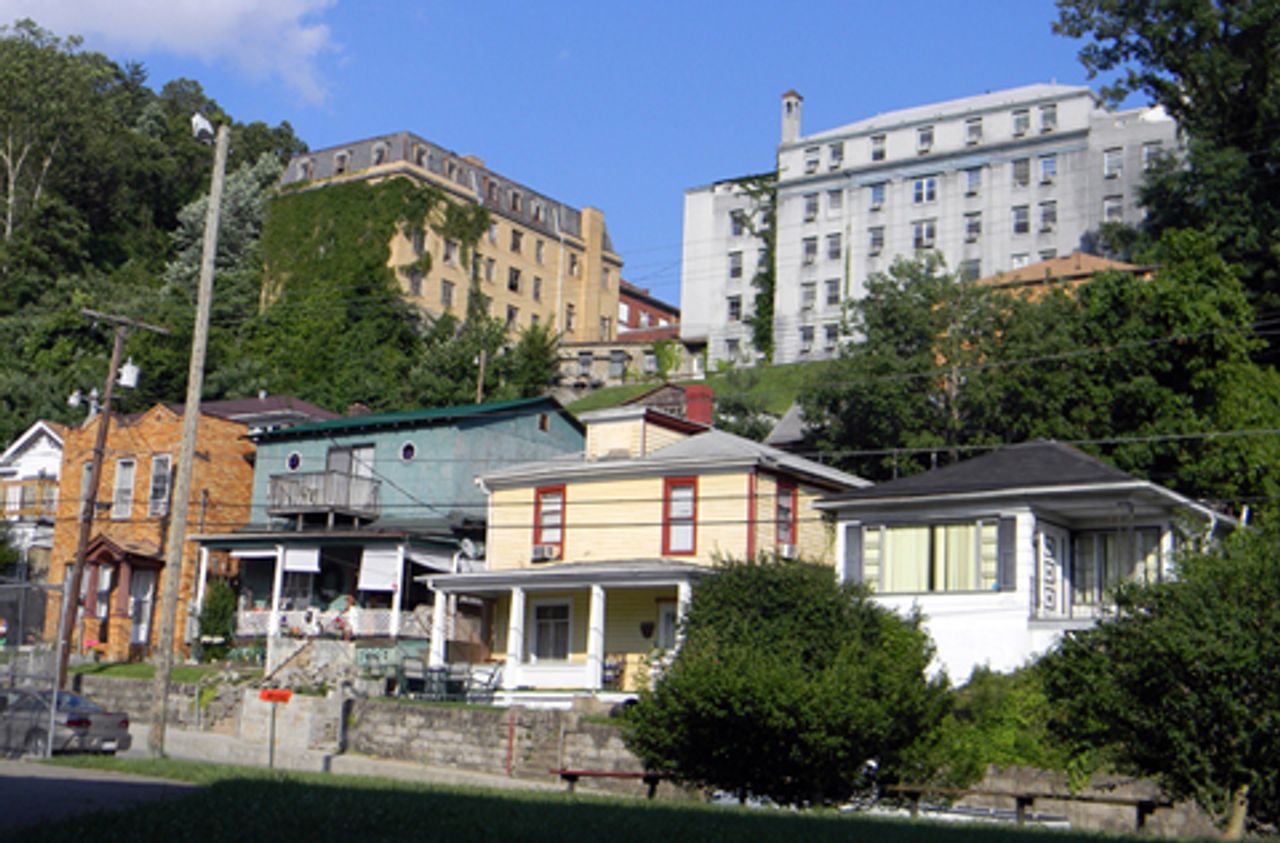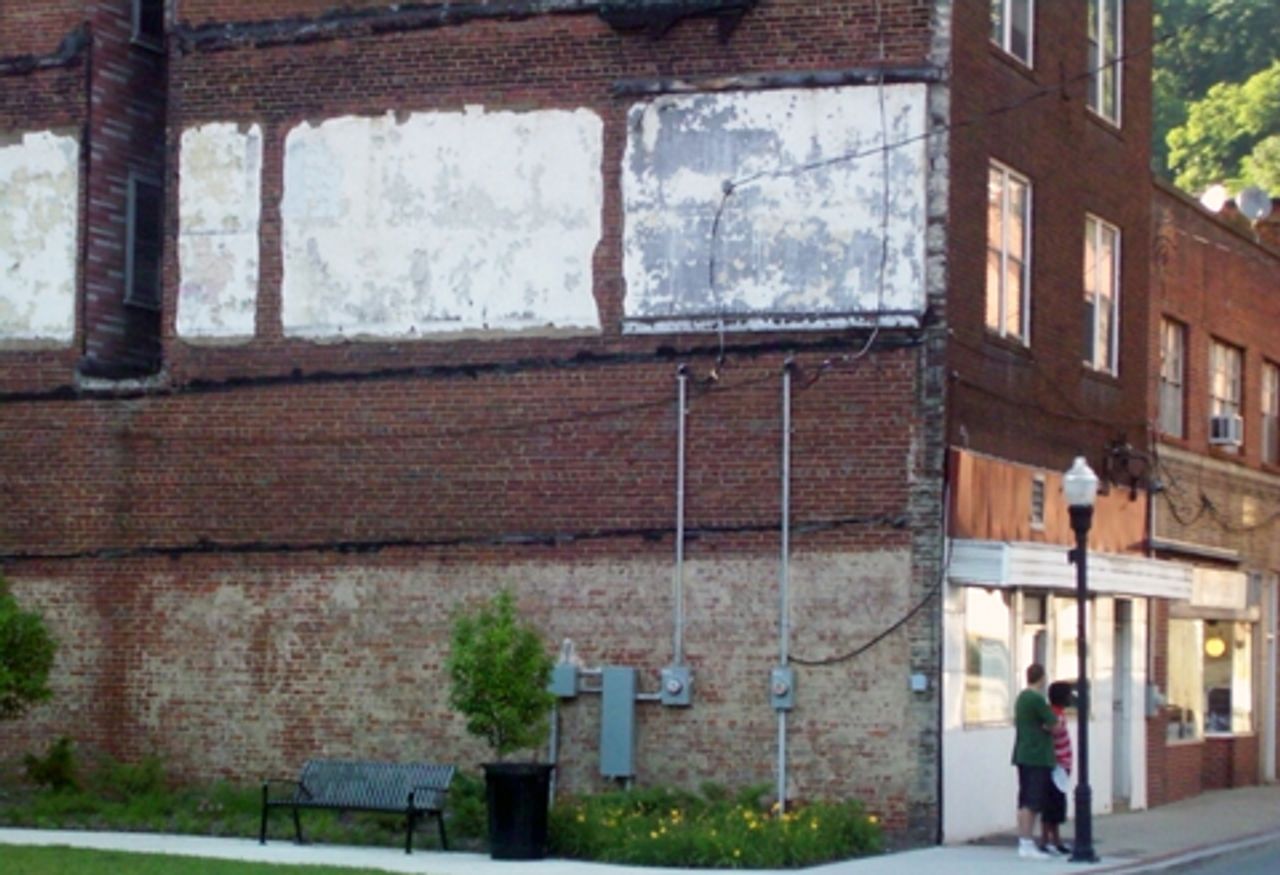By Hiram Lee:
This article is the fifth and final part of a series on the economy, social and environmental conditions, and history in the Appalachian region of the United States. Part 1: Deprivation and inequality in the coalfields was published on July 22, Part 2: An epidemic of ill health among the poor on July 24, Part 3: Environmental disaster and private profit on July 27, and Part 4: Youth prospects on July 30.
World Socialist Web Site reporters recently visited the coalfields of southeastern Kentucky and southwestern West Virginia and interviewed residents on their conditions of life. Accompanying interviews and material are published in five parts here: Harlan, Kentucky resident speaks to the WSWS; Homeless in Harlan, Kentucky; Williamson, West Virginia, residents speak to the WSWS; Matewan, West Virginia, residents speak on dearth of services; Economic transformation of Welch, West Virginia: From mines to prisons.
Blair Mountain is a site of great historical importance. In 1921, this mountain range in southwestern West Virginia was the scene of an enormous battle between an army of miners who sought to unionize the state’s coalfields and an army of law enforcement officials funded by the local coal companies. It is one of the most significant events in the history of labor struggles in the United States and was the largest insurrectionary battle fought on US soil since the Civil War.
The mountain contains numerous artifacts from the battle and is rich with opportunities for archaeologists and historians to better understand the fight that took place there. But it is now threatened with destruction from mountaintop removal mining operations by the billion-dollar coal giants Arch Coal and Massey Energy.
Blair Mountain was added to the National Register of Historic Places in the spring of 2009, having been nominated for the list by Appalachian State University Professor of Anthropology Harvard Ayers and his colleagues. Ayers and a research team studied the mountain in 2006, after two archaeological surveys of the area carried out by Arch Coal revealed little evidence of the historic battle. Ayers’ team found far different results. They were able to map out 15 separate battlefields and uncovered thousands of artifacts dating back to the struggle at Blair Mountain.
The researchers’ victory in placing the battlefield on the historic registry was short-lived, however. One week later, Randall Reid-Smith, West Virginia’s state historic preservation officer (SHPO), had the battlefield removed from the list. Reid-Smith, who was appointed to his position by Governor Joe Manchin, a steadfast ally of the coal industry, cited protests by local property owners.
Harvard Ayers hired attorney John Bailey to examine the list of protesters. National Geographic reported his findings in June: “The list of objectors, Bailey discovered, included two dead men—one of whom had perished nearly three decades earlier—as well as a property owner who had sold her land years before the nomination process. In addition, Bailey identified 13 property owners who did not appear on the SHPO list at all. ‘The final count we reached was 63 landowners and only 25 objectors,’ Ayers said.”
“It’s like they’re trying to destroy anything that the union had to do with,” a retired West Virginia coal miner, Paul Nelson, told National Geographic. “I think they want to destroy Blair Mountain and all memory of it.”
In spite of the fraudulent character of the objector’s list, the removal of the site from the historic registry was not reversed. As mountaintop is no longer protected by its historical status; subsidiaries of Arch Coal and Massey Energy now have permits to mine there.
The Friends of Blair Mountain, a group including Harvard Ayers, Kenny King—whose ancestors fought in the historic battle—and members of the Ohio Valley Environmental Coalition and the Sierra Club have released a report documenting the destruction that has already occurred on the mountain.
The report states that five locations in the Blair Gap area, which have shown evidence of having been the site of heavy fighting in the 1921 battle, “have been impacted by bulldozing activity, including one previously documented site (46LG205) on file at the West Virginia State Historic Preservation Office, one previously unsurveyed site that shows evidence of being part of the 1921 defensive front, and two undocumented sites that have not been surveyed but which have great potential for being significant elements in the defensive line and overall battle.”
Analysis of the fourth disturbed site investigated by the researchers found “the whole top of this knoll bulldozed in a 3-4 meter-wide swath. Again, the disturbance involved the removal of topsoil, and therefore any archaeological remains from the battle have also been eradicated.”
The fifth disturbed site suffered the worst damage, according to the report. “From the gravel road, an access road has been cut leading to the top of the knoll. The disturbance on top runs roughly 100 meters along the knoll ridge, and is 3-10 meters in width at different points. One large extension runs to the east, extending approximately 25 meters with a width of 18 meters at its widest. Below the hill, an extensive area has been logged, with access roads running roughly 30 meters or so down the hill. Unlike the previous four sites discussed, this site is within an existing mining permit.”
Should mountaintop removal mining operations commence on the Blair Mountain Battlefield itself, an enormous archaeological and historical opportunity would be lost. Mountaintop removal mining is an incredibly destructive process in which hundreds of feet of a mountain’s summit are blasted away with dynamite in order to expose deep-running coal seams. The waste from this process is then dumped into neighboring valleys where it often buries streams and contaminates the region’s water supplies. The environmental calamity cause by such destructive mining operations is explored more fully in an earlier article in this series (See “Environmental disaster and private profit”).
The Battle of Blair Mountain
The Battle of Blair Mountain was the largest insurrection on US soil since the Civil War. An organized army of miners went to war with an army funded by the coal operators and led by the anti-union sheriff of Logan County, Don Chafin. By the end of the battle, President Warren Harding ordered the US Army in to assist in suppressing the revolt.
The events of Blair Mountain were ignited by the murder of Sid Hatfield. On August 1, 1921, Hatfield, the pro-union sheriff of Matewan, West Virginia, and his friend Ed Chambers were assassinated by C.E. Lively, an employee of the Baldwin-Felts Detective Agency, on the McDowell County courthouse steps in Welch. Lively was arrested but acquitted of all charges; even though the murders had occurred in full view of the crowd gathered at the courthouse that day, no one would testify against the Baldwin-Felts assassin.
The assassination was an act of revenge carried out by the Baldwin-Felts Detective Agency. In 1920, in an event dubbed the “Matewan Massacre,” Hatfield, with the support of armed miners, confronted 11 Baldwin-Felts gun thugs who had been hired by the Stone Mountain Coal Company to evict union miners from their company-owned homes. Hatfield attempted to arrest the Baldwin-Felts agents as they prepared to leave town by train. The confrontation escalated into one of the deadliest gunfights in US history. Sid Hatfield would later testify before the US Congress that between “fifty or seventy-five” shots had been fired during the encounter. Seven of the Baldwin-Felts thugs were killed in the fight, including Albert and Lee Felts, the brothers of the agency’s founder Thomas Felts.
While the Hatfield assassination was the spark that ignited the Blair Mountain insurrection, it was ultimately prepared by the absolutely devastating conditions facing the miners and the struggles they had endured for decades.
The decade preceding the Battle of Blair Mountain had seen a surge in labor struggles in the coalfields of West Virginia. Among them was the Paint Creek-Cabin Creek Strike of 1912-1913. During that strike, miners clashed with hundreds of so-called mine guards who were in reality little more than a band of gun thugs and strikebreakers organized by the Baldwin-Felts agency.
During this time, the West Virginia Coal mines had become the deadliest in the nation. In his book Life, Work and Rebellion in the Coal Fields, David Corbin writes, “[D]uring World War I the southern West Virginia coal diggers had a higher proportional death rate than the American Expeditionary Force.”
Miners’ lives were completely dominated by the coal companies. They lived in company towns in homes the company owned. Wages were paid in the form of “mine scrip,” which could only be used in company stores.
From the West Virginia state government, to its representatives in the US Congress, including Senators Clarence Watson and Howard Southerland, both of whom had longstanding ties to the coal industry, the miners faced a political establishment which gave its full support to the profit interests of the coal operators.
Thousands from the West Virginia coalfields went to fight in the First World War. Those soldiers from West Virginia who escaped with their lives returned to poverty and slave-labor conditions in the mines.
After the war, tensions increased dramatically in the coalfields. Corbin writes in his book, “Between 1919 and 1921, the southern West Virginia coal fields exploded in wildcat strikes. In one coal field alone, sixty-three work stoppages occurred within eleven months. At one time seventeen wildcat strikes were in progress simultaneously.”
In response to the growing socialist influence in the wake of the Russian Revolution, the West Virginia legislature imposed a so-called Red Flag law in 1919 aimed at curbing free speech and demonstrations in the coalfields.
Historian Robert Shogan in his 2004 study, The Battle of Blair Mountain, cites a resolution adopted by a union local in the Coal River region after the law was introduced, warning “the ruling class of this state” that “As a final arbiter of the rights of public assembly, free speech and a free and uncensored press, we will not for a single moment hesitate to meet our enemies upon the battle fields. And there amid the roar of the cannon and the groans of the dying and the crash of systems purchase again our birthright of blood bought freedom.” The UMW leadership immediately sought to have the resolution revoked and to distance itself from what came to be known as the “Red Bandanna army” in the region.
The eruption of these social tensions was all but inevitable. On August 7, just days after Hatfield’s murder, at least 5,000 coal miners went to the state capital of Charleston to present demands to the governor. There they attended a mass meeting at which labor organizers Mother Jones and Frank Keeney spoke. Keeney told the workers if they wanted to secure their rights they would have to do so with “a high-powered rifle.”
On August 20, thousands of miners began assembling at Lens Creek in Kanawha County, near Charleston, for the purpose of forming an army. The aims of the miners went far beyond demands for higher wages and better living conditions. So explosive was the anger of this army, that they prepared themselves to march to Logan County and kill Sheriff Chafin before moving on to Mingo County, where they fully intended to take over the entire county, release all pro-union activists from the prisons there, and bring an end to martial law and the so-called “mine guard” system.
While an accurate number of those involved in the battle may be impossible to obtain, it is believed the miners’ ranks had swelled to 4,000 by the time they began their march to Logan County. Estimates of the number of workers who ultimately joined the fight on Blair Mountain range from 10,000 to as many as 20,000. At least 2,000 of these were veterans of the First World War.
 Members of Chafin’s army fire on miners
Members of Chafin’s army fire on minersThe march had supporters and sympathizers throughout the region. Contemporary articles in the New York Times, which described the miners as an “army of malcontents,” reported “two thousand more armed union men” making their way from Pike County, Kentucky to take part in the battle.
The so-called “army of malcontents” assembled by the miners was, in fact, highly organized. Those among the miners who had served in the First World War schooled the rest in military discipline and tactics. Field hospitals were established by sympathetic doctors and nurses as well as mess halls in which three meals per day were served.
The militant, mass character of the miners’ uprising, coming only four years after the seizure of power of the Bolsheviks in Russia, terrified the political establishment. From the perspective of President Harding and West Virginia Governor Ephraim Morgan, the government could not afford to spare the most severe methods in order to suppress the insurgency.
The battle began August 26, 1921 as the miners’ regiments clashed with an army led by Sheriff Chafin and composed of police, the National Guard, Baldwin-Felts agents and what amounted to a volunteer militia on the Blair Mountain ridge at the Logan County border. Fighting lasted for one week, with an estimated one million rounds fired. As many as 30 men from Chafin’s army were killed, while between 50 and 100 miners died. Hundreds were wounded.
Learning of the battle, Governor Morgan sent a request to the Harding administration for the assistance of federal troops. An official statement released by the governor’s office read, “The Governor’s office is fully aware of the gravity of the situation. Two men were killed in the district while numerous stores on Cabin and Paint Creeks, along Kanawha River and Coal River have been entered by armed men and robbed of arms, ammunition and supplies. Trains have been stopped and forced by men with drawn guns to haul them to their destination.”
The Governor added that “every available resource will be utilized to restore law and order and trusts that it can be accomplished without bloodshed.” In fact, the most brutal efforts were mobilized to crush the miners’ uprising. Private planes hired by coal operators in Logan sent bombs raining down on the miners’ encampments.
 Miners with an unexploded bomb
Miners with an unexploded bombThe Harding administration sent in federal troops, including three companies from the 40th United States Infantry, who arrived in Logan County on September 3. The president’s orders had called for the use of more than 2,000 troops, machine guns, gas and more than a dozen bombers.
The rebellion was ultimately suppressed by September 5. Nearly 1,000 miners were arrested for their part in the battle. Hundreds were charged with insurrection, and dozens were tried in West Virginia for treason and murder. The defeat served to spearhead a counteroffensive by the coal industry.
Mine operators, pointing to the fall in demand for coal following the end of the war, attacked the miners’ already miserable wages and conditions, rescinding a $1.50-a-day raise they had previously won. The UMWA agreed to this claw-back without a fight, in the interest of “the perpetuation of the union.” In West Virginia, the UMWA signed off on an especially sharp drop in tonnage rates for the miners, and membership collapsed in the state, from 50,000 to only a few hundred. Nationwide, UMWA membership fell from 600,000 to under 100,000 over the course of the decade.
The Battle of Blair Mountain exposed to the world the brutality and exploitation in the coalfields of Appalachia. It also revealed the enormous strength of the working class. The social conditions in Appalachia drove tens of thousands of workers in that region into conflict. There was no shortage of courageousness, self-sacrifice and class solidarity to be found among them. The defeats and setbacks suffered were not due to any lack of willingness by the workers to fight and even sacrifice their lives to free themselves from exploitation. Ultimately, the subordination of labor struggles to the Democratic Party through the UMWA and the failure to adopt a consciously socialist program were decisive. For all the miners’ militancy and eagerness to fight, a “high powered rifle” was never a substitute for a revolutionary party and program.
The remarkable history of Blair Mountain and the struggles of miners throughout Appalachia provide rich lessons for the working class. Thousands upon thousands of workers fought to free themselves from the exploitation of the corrupt coal industry barons. A critical study of this period in US history is of enormous importance for working people today, both within the coalfields region and internationally, as we prepare for great and explosive struggles in the coming period.
Concluded
3 August 2010
The social crisis in Appalachia Part 4: Youth prospects
wsws


